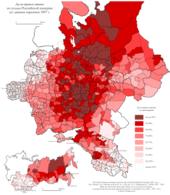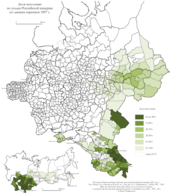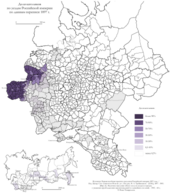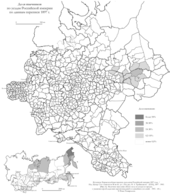Russian Empire census
The Russian Empire census, formally the First general census of the population of the Russian Empire in 1897,[a] was the first and only nation-wide census performed in the Russian Empire. The census recorded demographic data as of 9 February 1897 [O.S. 28 January]; with a population of 125,640,021, it made Russia the world's third-most populated country at the time, after the British and Qing empires. Although the census was performed in most of the empire, no enumeration was done in the Grand Duchy of Finland.
For other uses, see Russian census.First general census of the population of the Russian Empire in 1897
The census revealed the social class, native language, religion, and profession of citizens, which were aggregated to yield district and provincial totals. The data processing took eight years; publishing the results began in 1898 and was completed in 1905. In total, 119 books in 89 volumes were published for 89 governorates in the empire, including a two-volume summary.
The next census had been planned for December 1915, but was cancelled due to World War I.[1] It was not rescheduled before the Russian Revolution. The next census in Russia only occurred at the end of 1926, almost three decades later.
Background[edit]
Population censuses in Eastern Europe, as well as throughout the world, were carried out in one form or another throughout the existence of tribes, principalities, kingdoms, kaganates, khanates, kingdoms, empires, and states in order to determine the expected collection of income from subject territories and peoples.
In the thirteenth century, the Golden Horde enumerated the population of the Rus' three times—1245, 1257, and 1274; according to censuses, the Rus' population was then estimated at approximately 10 million people.[2] The population in the Tsardom of Russia under the reign of Peter the Great was about 15 million in 1710.
Previous censuses had been recorded for fiscal and military purposes. Until the eighteenth century, population records were sporadic, as in either scribal or census books. Audits began to be carried out at the beginning of the eighteenth century, and population censuses became relatively regular. Since 1858, the audit had been replaced by administrative and police registration of the population based on data from family lists. In total, three large administrative and police censuses of the population were carried out—in 1858, 1863, and 1885. Running population registrations – including births, marriages, and deaths – were carried out by religious organisations until 1918. All the items mentioned above were characterised by inaccuracy and insufficient completeness.
By 1897, significant experience had been accumulated in local, mainly urban, population censuses that had been conducted since the later half of the nineteenth century. Population censuses were performed in separate governorates (Pskov in 1870 and 1887, Astrakhan in 1873, Akmola in 1877, etc.), in which residents in all cities were enumerated. The population in the entire Courland Governorate was enumerated in 1863 and 1881, and in the governorates of Livonia and Estonia in the latter. Registration of the rural population was performed during household and other surveys of zemstvos. In 1871, under the general editorship of the professor of military statistics, Nikolai Obruchev, officers of the General Staff published a military statistical collection, the four-volume edition of which contained data on the population of Russia as a whole, and was categorised by governorates and okrugs.
In 1870, the project for an all-Russian population census was discussed at the First All-Russian Congress of Statisticians, and in 1876, at the eighth session of the International Statistical Congress. On 26 February 1877, the draft of "Regulations on the General National Census", which was developed by a commission under the Ministry of Finance, was submitted to the State Council; however, it was not discussed there, possibly due to the Russo-Turkish War that occurred from 1877 to 1878. In the early 80s of the nineteenth century, the Ministry of Internal Affairs began to receive statements from some zemstvo assemblies and governors about the need to conduct a population census as soon as possible; this was due to the unbalanced distribution of taxes among peasant families and an increase in arrears in collections from the population. After the famine of 1891–1892, the question of the obligation to have accurate figures of the population of the empire again arose.
Organization[edit]
The census project was suggested during 1877 by Pyotr Semenov-Tyan-Shansky, a famous Russian geographer and director of the Central Statistical Bureau, and was approved by Czar Nicholas II in 1895.
The census was performed in two stages. For the first stage (December 1896 — January 1897) the counters (135,000 persons: teachers, priests, and literate soldiers) visited all households and filled in the questionnaires, which were verified by local census managers. For the second stage (9 January 1898 [O.S. 28 December 1897]) the counters simultaneously visited all households to verify and update the questionnaires. The census was performed during winter as the population was less mobile then.[3] Despite this being the only imperial census, historians are able to estimate the Russian Empire's population during earlier times by collecting city censuses.
The data processing required 8 years using Hollerith card machines. Publication of the results started during 1898 and ended in 1905. In total, 119 volumes for 89 guberniyas, as well as a two-volume summary, were issued.
The questionnaire contained the following questions:
In the census summary tables, nationality was based on the declared primary language of respondents.
Data availability[edit]
Each enumeration form was copied twice, with the three copies filed in the Volost (county) archives, the governorate archives, and the Central Statistical Bureau in St. Petersburg. The copies in St. Petersburg were destroyed after they had been tabulated.[7][3] Most of the copies stored locally and regionally have also been destroyed; however, the complete census for the Arkhangelsk and Tobolsk governorates has been preserved, and the census for portions of several other governorates is also extant.[8][9]
Assessment[edit]
The results may have been influenced by national policy of the authorities: the population of Russian ethnicity was somewhat exaggerated.[10] Thus for example, the number of Poles is underrepresented.[11][12] Imperial officials classified the Ukrainian and Belarusian languages as belonging to the Russian group and labeled those nationalities as Little Russian for Ukrainians and White Russian for Belarusians.[10]
The census did not contain a question on ethnicity, which was deduced from data on mother tongue, social estate and occupation. There was also a 1916 and 1917 "agricultural census" that was carried out throughout the empire (except in some parts of the Caucasus, Eastern Russia, and Siberia), and a 1920 "general census" (except in the Russian far north, far east, Ukraine, and the Caucasus).[13]








